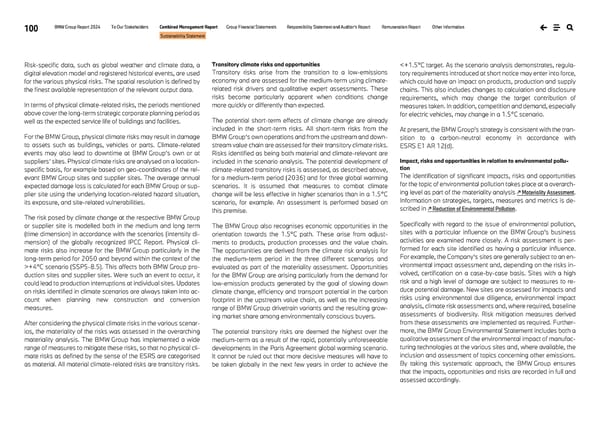100 BMW Group Report 2024 To Our Stakeholders Combined Management Report Group Financial Statements Responsibility Statement and Auditor’s Report Remuneration Report Other Information Sustainability Statement Risk-specific data, such as global weather and climate data, a digital elevation model and registered historical events, are used for the various physical risks. The spatial resolution is defined by the finest available representation of the relevant output data. In terms of physical climate-related risks, the periods mentioned above cover the long-term strategic corporate planning period as well as the expected service life of buildings and facilities. For the BMW Group, physical climate risks may result in damage to assets such as buildings, vehicles or parts. Climate-related events may also lead to downtime at BMW Group’s own or at suppliers’ sites. Physical climate risks are analysed on a location- specific basis, for example based on geo-coordinates of the rel- evant BMW Group sites and supplier sites. The average annual expected damage loss is calculated for each BMW Group or sup- plier site using the underlying location-related hazard situation, its exposure, and site-related vulnerabilities. The risk posed by climate change at the respective BMW Group or supplier site is modelled both in the medium and long term (time dimension) in accordance with the scenarios (intensity di- mension) of the globally recognized IPCC Report. Physical cli- mate risks also increase for the BMW Group particularly in the long-term period for 2050 and beyond within the context of the >+4°C scenario (SSP5-8.5). This affects both BMW Group pro- duction sites and supplier sites. Were such an event to occur, it could lead to production interruptions at individual sites. Updates on risks identified in climate scenarios are always taken into ac- count when planning new construction and conversion measures. After considering the physical climate risks in the various scenar- ios, the materiality of the risks was assessed in the overarching materiality analysis. The BMW Group has implemented a wide range of measures to mitigate these risks, so that no physical cli- mate risks as defined by the sense of the ESRS are categorised as material. All material climate-related risks are transitory risks. Transitory climate risks and opportunities Transitory risks arise from the transition to a low-emissions economy and are assessed for the medium-term using climate- related risk drivers and qualitative expert assessments. These risks become particularly apparent when conditions change more quickly or differently than expected. The potential short-term effects of climate change are already included in the short-term risks. All short-term risks from the BMW Group’s own operations and from the upstream and down- stream value chain are assessed for their transitory climate risks. Risks identified as being both material and climate-relevant are included in the scenario analysis. The potential development of climate-related transitory risks is assessed, as described above, for a medium-term period (2036) and for three global warming scenarios. It is assumed that measures to combat climate change will be less effective in higher scenarios than in a 1.5°C scenario, for example. An assessment is performed based on this premise. The BMW Group also recognises economic opportunities in the orientation towards the 1.5°C path. These arise from adjust- ments to products, production processes and the value chain. The opportunities are derived from the climate risk analysis for the medium-term period in the three different scenarios and evaluated as part of the materiality assessment. Opportunities for the BMW Group are arising particularly from the demand for low-emission products generated by the goal of slowing down climate change, efficiency and transport potential in the carbon footprint in the upstream value chain, as well as the increasing range of BMW Group drivetrain variants and the resulting grow- ing market share among environmentally conscious buyers. The potential transitory risks are deemed the highest over the medium-term as a result of the rapid, potentially unforeseeable developments in the Paris Agreement global warming scenario. It cannot be ruled out that more decisive measures will have to be taken globally in the next few years in order to achieve the
 BMW Group Report 2024 Page 99 Page 101
BMW Group Report 2024 Page 99 Page 101